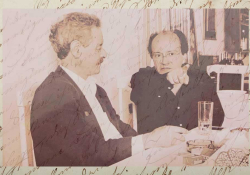Multitasking: The Narrative Alchemy of Maylis de Kerangal

In early 2014, Maylis de Kerangal wrote a short text entitled À ce stade de la nuit [At this point of the night] at the invitation of the “Rencontres littéraires en pays de Savoie,” a literary meeting that was held on June 14, 2014, in Chamonix. A limited edition of that text was published in the “Paysages écrits” collection of the Éditions Guérin in May 2014. A year and a half later, in October 2015, it was republished in a more conventional, more commercial form by the Éditions Verticales, where seven of Kerangal’s previous books had appeared.1 It was that republication which produced two of the most extraordinarily vituperative reactions that French literature has seen in recent years.
The first, a review by Frédéric Beigbeder, appeared in Le Figaro on October 23, 2015, under the title “Lampedusa mon amour.” A text of barely four hundred words, Beigbeder’s reading of Kerangal’s text makes up for its brevity by the sheer savagery of its tone. He launches his attack by quoting Marguerite Yourcenar’s remark about Marguerite Duras’s Hiroshima mon amour, “And why not Auschwitz my darling?”2 He registers his fervent thanks that Kerangal’s book contains merely seventy-four pages, and that those pages are often punctuated by blank spaces, which conveniently provide the reader with “room to guffaw.” He accuses Kerangal of aestheticizing the name “Lampedusa,” instead of attending to the tragedy of the refugee shipwreck just off the coast of that island, the event that occasions À ce stade de la nuit. Upon hearing the news of that tragedy, rather than thinking of Burt Lancaster in Visconti’s The Leopard, and Giuseppe di Lampedusa’s novel of the same name, Beigbeder argues that Kerangal could have broken into tears or could have taken a plane to Lampedusa in order to feed the survivors of the shipwreck. Instead of acting, she of course chooses to write; but what she writes clearly fails to please Beigbeder. He characterizes her book as “a true monument of involuntary comedy,” and he signs off with a devastating caricature of Kerangal as “a neo-Duras in her kitchenette.”
Richard Millet’s reading of Kerangal’s book is less cursory than Beigbeder’s, but it is no less vicious. It appeared a few months after Beigbeder’s review, as the lead article in the January–February 2016 issue of La Revue Littéraire, a journal where Millet himself serves as editor-in-chief. Affixing the provocative title “Pourquoi la littérature de langue française est nulle” (Why French Literature Is Worthless) to his piece, Millet’s very first sentence leaves no doubt that he holds Maylis de Kerangal personally responsible for the degenerate state into which French literature has fallen, in his own grim view of things: “It seems like Mme de Kerangal has been called to exercise over French literature, as it might have been put in a more literary period, an unquestioned authority—at least she sets the tone in France where, in matters of culture, truth is less respected than image, sales figures, and ideological purity.” Deploring the liberal-leftist social vision that dominates the novel today, Millet contends that Kerangal is writing for an ignorant, deculturized international petite bourgeoisie. He faults Kerangal for her attention to words and ideas: “She clings to words. She dabbles in terms and concepts.” He criticizes her for invoking the economic migration in the Mediterranean, while saying nothing about the internal exile of millions in the former Soviet Union. He suggests that even the most destitute among the North African migrants would refuse to read Kerangal, and he is convinced that she cares not one whit about those individuals, seeing in them merely a trendy literary motif. In a truly breathtaking gesture, Millet offers À ce stade de la nuit as the very image of contemporary French literature’s shipwrecked state, laying the blame for that latter catastrophe squarely at the feet of those people misguided enough to read Kerangal:
This book, which would taste just like a tofu steak if it weren’t for the humanitarian lard in which it is wrapped, testifies to the shipwreck of French literature: the reader is required to acquiesce in this ideological infantilization, wherein clichés compete to construct a text so smooth that it is indistinguishable from every other disposable novel that is published each autumn. The thousands of imbeciles who read Babyliss de Kerangal are guilty of fostering an imposture and, at this point of the disaster, the illusion that contemporary literature exists, whereas it is merely recycled propaganda written in a transgenic language.

One might remark many things about the readings of Kerangal that Beigbeder and Millet put on display. One recognizes in the first instance that both of those individuals have carefully cultivated their own reputations as polemicists during their careers, reputations that must be liberally fertilized if they are to grow. One might register the pronounced ad hominem character of their attacks, as if it were really the person of Maylis de Kerangal that they find so abhorrent, rather than her book. One might comment upon the astonishing brutality of their language, or the way they refuse to admit that anything of any value at all might be discovered in her book. One might note that the narcissism which they both bemoan in À ce stade de la nuit is beggared by the narcissism that colors their own readings of that text. And so forth. Rather than pursuing those avenues of inquiry, however, I would like to concentrate on one way in which both Beigbeder and Millet misread Kerangal’s book. For I believe that an examination of that misreading can help to bring into evidence what that book is actually about—and I view that latter process as something that is critically useful.
What we think of as good writing is never about one thing only. To the contrary, it is always about a variety of things, simultaneously and in a dynamic of reciprocal complementarity.
Both Beigbeder and Millet reproach Kerangal for not attending to the migrants and the catastrophe of the Lampedusa shipwreck. They would demand of her a close and exclusive focus on those people and that disaster, in a book that speaks about one thing, and one thing only. They fail to realize (or they deliberately refuse to realize; the distinction is largely otiose here) that what we think of as good writing is never about one thing only. To the contrary, it is always about a variety of things, simultaneously and in a dynamic of reciprocal complementarity. That is particularly true in the case of the novel—and neither Beigbeder nor Millet takes À ce stade de la nuit for anything other than a novel, despite the fact that they demand of it things that novels typically do not provide. Artlessness, for instance, and univocity, and uninflected testimony. Both of them moreover assume that it is Kerangal who speaks in the text in an utterly direct and unmediated fashion, rather than a narrator who may not be absolutely identical to the author in every regard.3 Most critics, it is safe to say, believe as a matter of principle that there is some distance between the narrator of a novel and the novel’s author, however much those two figures seem to resemble each other.
In short, the most pernicious feature of the readings that Beigbeder and Millet offer is the fact that they are so starkly reductive. That may be a matter of strategy, or it may be a matter of negligence; either way, it is clear that the text they denounce with such vehemence is not the text that Kerangal has written but a caricature thereof. For novels are not simple matters, after all—even in the case of apparently “simple” novels. They are never purely univocal, and their attention is always to some degree divided.4 Novels are richly various in voice and in focus. They are multitools equipped for multiple uses, like a Swiss Army knife. And if some of their blades are used more often than others, if some of their edges are more finely honed, that does not prevent the tool from serving a variety of purposes, in manners that are demonstrably incisive. I would like to attend to that demonstration right now in another kind of reading of À ce stade de la nuit, one that acknowledges the plurality of the novel and imagines its author as someone engaged in a process one might describe as creative multitasking.
In the first scene of the book, Kerangal puts onstage a woman sitting alone in her kitchen, late at night, listening to the radio—and indeed that initial setting, as static as it may seem, colors the novel from beginning to end. That woman narrates the story, speaking in the first person. We learn that she lives in Paris, that she likes movies, and that she writes books for a living. Insofar as one can speak of “event” in this text, it is the radio that provides it. It comes in the form of catastrophe, a broken, stuttering account of catastrophe, which the narrator strives to reconstruct in a more coherent fashion: “I collect and organize the information that fills the radio waves, soon saturating them, I stretch it into one sentence: a boat coming from Libya, with more than five hundred migrants in it, sank this morning less than two kilometers from the coast of the island of Lampedusa; it is feared that there have been more than three hundred victims.” That event is immediately recognizable by anyone who has been paying attention to world news during the past few years of our vexed contemporaneity, and it allows us to situate the time of the narrative “now” with some precision, for the Lampedusa shipwreck occurred on October 3, 2013.5
Tensions, ironies, and contrasts of various sorts animate the text throughout, and some of them become clear in the very first pages. Most obviously striking is the yawning distance between the two focal sites in the novel, Lampedusa and the narrator’s nighttime kitchen. Kerangal invites us to consider that distance on a variety of levels—and she constructs the narrative economy in ways that oblige us to do so. On one hand, there is disaster and the frantic activity that it demands; on the other hand, there is a largely passive reception of the account of that disaster. In Lampedusa, human lives are at stake, and many are in fact lost; in Paris, nothing very dire hangs in the balance. Two quite different realities are in question here, the one dominated by destitution and calamity, the other insulated by bourgeois privilege. One world is colored by action, the other by reflection. One is collective, social, and political; the other is individual. One world is far away, and reports about it testify to that distance; the other is much nearer to us, and we learn about it immediately. In short, one reality is there, the other is here; one involves them, the other involves the I—and the matter of how those differences play upon each other is the central question of Kerangal’s book.
The fulcrum of that play is the word “Lampedusa.” In the very first moments of the text, when the narrator is listening distractedly to the radio and before the account of the disaster becomes clear to her, it is that word, rather than any other, which the narrator seizes:
At low volume, the radio broadcasts a web of sound that murmurs into space, spins and turns like a gymnast’s ribbon. I don’t react immediately to the impeccably modulated voice which, introducing the news report after the twelve strokes of midnight, stutters the sinister tragedy that occurred this morning, I perceive merely an acceleration, something is taking shape, something febrile. Soon, a name is uttered: Lampedusa. (9–10)
That word echoes through À ce stade de la nuit from first page to last. It conditions the narrator’s reception of the news she hears, and it structures her meditation upon that news. As a signifier, it is powerfully performative even when its discursive context is less than clear. When the narrator listens to people testifying about the disaster in Italian, for instance, “Lampedusa” is the one clearly understandable word: “Italian voices, metallic, saturated with sentiment, vibrate under the flatter voices of the reporters. They frame Lampedusa in its native language, where I identify it easily—it is strange to recognize how indifferent the proper name is to the sentence in which it takes its place and where it rolls between other words like a stone that, nonetheless, propagates its poetry.”
One may remember that Roland Barthes called the proper noun the prince of signifiers,6 and quite patently such is the role that Kerangal reserves for “Lampedusa” in this text. “I explore this name,” remarks the narrator, and during the course of her exploration she will realize that “Lampedusa” is not only a toponym but also an anthroponym; that it is deeply embedded in both a mythology of place and a mythology of person; that it is already bound up in narrative, “This name that is already a story”; and that it has very considerable personal significance for her. The story that the name conjures up for her is in the first instance deeply wedded to the image, because the narrator reads the word “Lampedusa” through her own experience of cinema: “The first image that comes to my mind is Burt Lancaster’s face. [. . .] He is Don Fabrizio, Prince Salina, he is Luchino Visconti’s The Leopard: it’s him.” In other words, as she struggles to come to terms with the news on the radio, the narrator seizes upon what seems to her like the richest and most insistent signifier in the broadcast, the name “Lampedusa.” That name gives forth upon a cultural horizon that is familiar to the narrator, and she will put that cultural horizon to use in her efforts to understand events. She recalls, for instance, that Visconti had filmed the ball scene (which lasts an hour and with which the movie ends) as a kind of shipwreck, yet of a very different sort than the one she hears about on the radio, one involving the final days of traditional Sicilian feudalism.
The interplay of word and image is intriguing, moreover, because if the word “Lampedusa” evokes most immediately the image of Burt Lancaster’s face for the narrator, that face is in turn deeply evocative of language, and more specifically, of written language. To the narrator’s way of thinking, Lancaster possesses “an actor’s face, in other terms a face covered with writing.” And that face, through the mediation of the name “Lampedusa,” will eventually serve to put in evidence another piece of writing, one that clearly serves as an intertext in the economy of À ce stade de la nuit: “Burt Lancaster is now covered with another level of signs: nine letters, of which two are identical. Or rather Lampedusa, when I see it, when I pronounce it aloud, ceases to evoke merely a face, instead calling up four words composing a name on the cover of a book: Giuseppe Tomasi di Lampedusa.” In one of the many quiet ironies that Kerangal constructs, it is the film that introduces the novel, rather than the other way around—despite the fact that Lampedusa’s Leopard quickly became the most best-selling Italian novel after its publication in 1958 and has been far more broadly recognized than Visconti’s Leopard. But that is how the association of ideas works, clearly; and that, in turn, is a major theme in Kerangal’s novel.
Once again, it is the proper name upon which that process hinges, and in this case the distinction between toponym and anthroponym is difficult to parse. Kerangal reflects upon that name, “without however knowing whether it is the island—Lampedusa—that belongs to the man, or the man—Giuseppe Tomasi—that belongs to it.” More than anything else, it is the nobiliary particle that puts place and person into play, for of course the man is from the place, and the place in some sense defines the man. That dynamic is clearly on the mind of Kerangal’s narrator as she listens to her radio: “I’m thinking now about proper names that are toponyms, and about anthroponyms that designate places.” Moreover, it is not coincidental that Kerangal’s own name contains a nobiliary particle, and she exploits that to set up yet another delicate irony, this one devolving upon the unbalanced analogy of one writer and another. But the most powerful effect of her meditation on onomastics is the way that it sets up the idea of belonging, an idea that takes on a very different shape when one considers the situation of the North African refugees. For they are nameless in the reports of the shipwreck that the narrator receives: “After all, what is important, right now, is the death of an unknown number of anonymous people.” That very anonymity makes it very difficult to imagine them, to particularize them, to represent them. In fact, the only names that may avail in the process are toponyms rather than anthroponyms: “other names barge in, one after another: Eritrea, Somalia, Malta, Sicily, Tunisia, Libya, Tripoli.”
A representational difficulty lies at the heart of À ce stade de la nuit. How does one speak about people if one doesn’t know their name?
That representational difficulty lies at the heart of À ce stade de la nuit. It is a dilemma with which both Kerangal and her narrator must grapple, on different levels. How does one speak about people if one doesn’t know their name? How can one call attention to their plight? The problem is necessarily imbricated in onomastics, and it serves to put in evidence yet another tension, the one between fact and fiction. For the proper name traverses the frontier between those two latter domains with an astonishing ease, as the narrator recognizes when she reflects upon the names “Lampedusa” and “Salina”:
I put those two names designating a same man, prolonging a same first name, Fabrizio, side by side. I try to intercept that which circulates between them, these comings and goings, this twisting loop of meaning. Or how the real name invokes and veers toward the fictional name, migrates from the civil registry to the novel, from the Almanach de Gotha to literature; or how the fictional name can recover the real name. I shudder with pleasure and rub my palms against each other when I remember that Salina is also a toponym, that it also designates an island in the Mediterranean, one not located to the south of Sicily like Lampedusa, but to the north, in another archipelago, that of the Aeolian Islands: two names for two islands. From one name to another, from one island to another, the migration continues. (32–33)
That meditation on the name is what allows the narrator to negotiate the dilemma of representation, insofar as she can. For if she cannot name the victims of the shipwreck, she knows the name “Lampedusa”—indeed, she can pronounce the word aloud.7 It functions much like an incantation, firing her imagination and opening onto a variety of perspectives upon which Kerangal’s narrator will cast her gaze, one after the other, by association. She is a writer after all, that is to say a person who spends a lot of time in her own head. The fact that many of those associations should be subjectivist in character is not particularly shocking, for people typically avail themselves of anything readily at hand when it is a question of coming to terms with disaster. According to Agnes Woolley and Mariangela Palladino, moreover, that associative approach is one of the key strategies that artists can use in order to comment effectively upon crisis in the world today.8 For patently enough, novelists are not journalists; their tools and techniques are very different, and the ways they account for events are likewise very different.
That is why I insisted on Maylis de Kerangal as a multitasker a moment ago. In the efforts her narrator puts forth to understand a very difficult reality, she turns this way and that, both inward and outward, pursuing an interpretational path that is constantly forking, whose various branches are all connected to the root that the name “Lampedusa” provides. That path leads through Visconti’s film, Burt Lancaster’s face, and Giuseppe di Lampedusa’s novel. One of its main branches points inward and involves a reflexive, introspective dynamic that puts the “I” on trial and asks useful questions about how people interpret events that are well beyond their ken. Thus, while the narrator recognizes that Visconti’s Leopard is a broadly public artifact, her manner of thinking about it is intensely personal. She remarks that the film won the Palme d’Or in Cannes in 1963, locating that date with regard to her own birth, four years later. She rehearses her viewing of the film over the years, including the most recent one, at the “Reflet Médicis, rue Champollion” (20), situating that event firmly in personal time and space. She ponders her own understanding of the film, and how that understanding has evolved.
In those moments of Kerangal’s book, the “I” obviously occupies the center of the stage. But it is an “I” that is far more complex than the one which Beigbeder and Millet imagine. It is necessarily and insistently multiple, and it is significantly mobile as well. The interrogation of that “I” is clearly one of the tasks that Maylis de Kerangal has set for herself in À ce stade de la nuit, and she goes about that task with a great deal of purpose. First and foremost, is it an “I” that is constantly engaged in interpretation. Even as she listens to the radio, the narrator scans the newspaper in search of information: “at this point of the night,” she remarks, “I leaf through the pages of the newspaper, scanning them distractedly, I check the headlines, the captions of the photos, I pay attention to italics, bold letters, and capital letters, I dig a bit deeper into the pavement of the texts.” Never having visited Lampedusa, she recalls several visits to Stromboli, attempting to imagine Lampedusa through analogy. For all its foreignness, she feels a sense of belonging in Stromboli by virtue of her experience, and more particularly still in view of the fact that she has written about that experience. This is one of the sites where Kerangal plays most intensely on the distinction of author and narrator, for in some moments of her text she vexes those figures one against the other, in order the see what sparks may fly. Thus, her narrator mentions, “I go get one of my books, Ni fleurs ni couronnes, a collection of two short stories, both situated on islands, Ireland and Stromboli,” and we readers may recognize that Maylis de Kerangal has authored a book of that title. Thus too, a bit earlier, the narrator remarks upon a sign alongside a highway in the southwest of France with the name “Maylis” on it, and another in Brittany displaying the name “Kerangall.” It is important to recognize Kerangal’s game for what it is, however, for those moments are largely anecdotal ones in the economy of this text, where the focus is drawn so closely upon imagination, memory, interpretation, and writing, those activities in which both author and narrator are so deeply engaged. “I like the notion that the experience of memory, that is, the action of remembering, changes places into landscapes, transforms illegible spaces into story,” and indeed that special kind of narrative alchemy is always at issue in this book. It is precisely that which will enable the narrator, in the final pages of the book, to imagine the catastrophe in Lampedusa, and to render an account of it.
The book allows an outsider to feel at home in an unfamiliar landscape. In other words, books are a site of hospitality.
That process involves the other principal branch in the path that Kerangal follows, one that points outward, rather than inward, toward the world rather than toward the self. For the narrator, it is writing and its material result, the book, that enable a constructive engagement with the world. Speaking about Stromboli, she remarks: “I feel like I’m coming to a place I can call my own, somewhere I feel at home precisely because I came there as a foreigner, just like I come to a book.” To her way of thinking, the book allows an outsider to feel at home in an unfamiliar landscape. In other words, books are a site of hospitality—and that very idea, in different guises, subtends much of Kerangal’s argument in À ce stade de la nuit. Reflecting on Giuseppe di Lampedusa’s many accomplishments as a writer, a critic, and a professor of literature, the narrator muses that his Leopard “weaves together the political novel, a social panorama, and a meditation on time,” accommodating thus many different inquiries in mutually complementary ways. Recalling her reading of Bruce Chatwin’s The Songlines, she admires the way the aboriginal narrative form he describes plays with a clan’s proper names and manages to be both myth and poetic remembrance. Thinking about islands, she suggests that they are crucibles of fiction, characterizing them moreover as “heterotopias,” different places welcoming different kinds of people, people who would not find the same hospitality on the mainland.
All this speculation reads like a blueprint for the book that the narrator wishes to write—and for the one that Kerangal does in fact write. Crucially, such a book is defined by its hospitality, that is to say, by the way it accommodates difference. In that perspective, it is not surprising that the account of the Lampedusa shipwreck which the narrator offers as a final gesture (and toward which each of the narrative paths she has followed previously inevitably leads) should end with a single-word utterance: “Hospitalité.” For her, that is the promise of “Lampedusa,” as the island receives the survivors of the shipwreck. More generally speaking, throughout this book Maylis de Kerangal herself is arguing a brief for hospitality as a principle of human action. As she describes it, it is a principle that wagers far more upon multiplicity and difference than upon singularity and identity. Her book dramatizes that wager in its very composition, moreover, attending to a rich variety of purposes in ways that reveal the reciprocal affiliations of those purposes, achieving thus something more substantial than what might have been obtained by more singular means. Kerangal clearly understands the advantages of that plural approach, recognizing how well it can serve a writer, most especially when that writer is faced with a difficult task. It can serve critics equally well, I would submit—or at least when critics take their job seriously.
University of Colorado
Footnotes
[1] These publication details can be found in Kerangal’s À ce stade de la nuit and in the Wikipédia entry entitled “À ce stade de la nuit.”
[2] My translation, here as elsewhere. The French original reads: “Et pourquoi pas Auschwitz mon chou?” In the Journal du Dimanche of December 2, 1984, Yourcenar remarked, “There is only one thing for which I cannot forgive Marguerite Duras: the title, Hiroshima mon amour. I’ve been to Hiroshima. Terrifying. As if, having been to Auschwitz, one wrote, Auschwitz, my darling!” [Une seule chose que je ne pardonne pas à Marguerite Duras: ce titre, Hiroshima mon amour. Hiroshima, j’y suis allée. Effrayant. Comme si, après avoir été à Auschwitz, on écrivait Auschwitz, mon petit chou!]. See Frédéric Jézégou, “Citation-115398,” Dicocitations, LeMonde.fr, 2016.
[3] See Millet, describing the setting of À ce stade de la nuit: “A woman (the author, undoubtedly) is sitting sideways in her kitchen. She is drinking reheated coffee” (La Revue Littéraire 61 [2016]).
[4] On the notion of divided attention in literature, see Ross Chambers, Loiterature (University of Nebraska Press, 1999), 8–15.
[5] Or the first one, at any rate, for there was a second shipwreck off Lampedusa on October 11 of the same year.
[6] Barthes writes: “A proper noun must always be closely questioned, because the proper noun is, if I may say so, the prince of signifiers; its connotations are rich, social, and symbolic.” See “Analyse textuelle d’un conte d’Edgar Poe,” in Sémiotique narrative et textuelle, ed. Claude Chabrol (Larousse, 1973), 34.
[7] See 39–40: “I thought about the silent matter that escapes from names, about what they write with invisible ink. Speaking aloud, my back straight, sitting up on my chair with my hands flat out on the table—and undoubtedly ridiculous to whoever might have walked in on me, so solemn, so constrained was I, right at that moment—, I pronounce gently: Lampedusa.”
[8] In a piece entitled “The Arts and Humanities: Tackling the Challenges of Mass Displacement,” they write: “What art and literature can do more generally—actively, even—is to draw out the intersecting temporalities and territories that constitute our contemporary moment and seek lines of connection between the varying means we have to understand and shape our responses to displacement and migration. The arts allow us a way into social and political questions and the moral and ethical assumptions that underpin them: questions about humanitarianism as political practice and humanism as a set of values” (openDemocracy, October 3, 2016).










